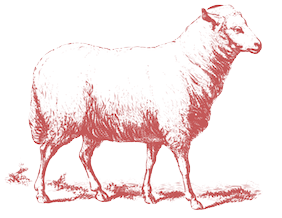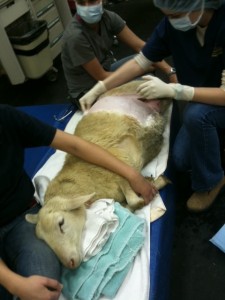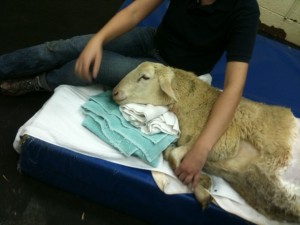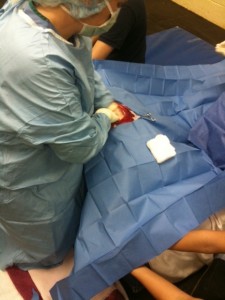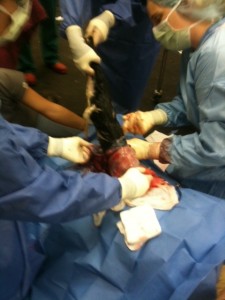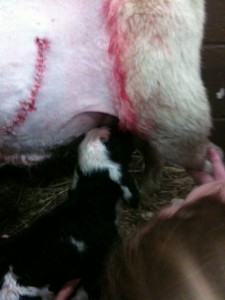For the past two years, the second weekend in March we have attended the annual Georgia Organics Conference. We've loved going to this conference for the inspiration, camaraderie, and learning opportunities that are typically abundant, but this year we didn't go. This year, instead of buckets of inspiration, we spent the weekend at the University of Georgia getting sacks full of "this is really hard." Friday morning, we had a ewe who had lost a bag of waters, but whose labor had completely halted. Ross and I went out to catch her, and I performed an internal exam to see if she perhaps had a stuck lamb that needed assistance. So, I lubed my arm-length glove and found that there was no lamb in the birth canal and that I could only get two fingers into her cervix. I gave the tissue a gentle massage to see if it would give, but it felt completely taut and would not soften. We called our friend Nancy Osborn of Cordero Farms who has years of sheep and lambing experience. She advised us to seek out a vet at this point. Unfortunately, there is a real dearth of large animal vets in Georgia (unless you're talking horses) and none who will come out to our farm. So, we packed her up and drove 2 hours up to the vet school at UGA. The vet performed an ultrasound and found that the lamb, much to our collective surprise, was still alive.
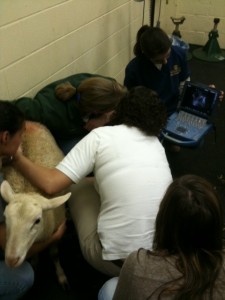
They also confirmed that her cervix was only partly dilated and was not going to go any farther. She had a condition called "ringwomb" (more on that in a moment). The only way to have a chance to save both of them was to preform an emergency c-section. This was a tough choice that really tested the ethics of our business. Surgery on any animal is costly, and as a start-up business without a lot of income, it's pretty prohibitive, but it was a choice between letting this animal and her lamb die or the possibility of saving one or both. The value of both the lamb and the ewe together was more than the cost of the surgery, but if one or both died in the process, we would be losing a serious amount of money. If one or both lived, the financial loss would be less, and frankly, so would the weight on our hearts. So, we gave the green light to perform the surgery.
After the lamb was born, the vets insisted on keeping them overnight for observation. At first, the ewe seemed to be recovering and was letting the lamb nurse, but by the next morning she was rapidly deteriorating. She was developing sepsis from failure to pass the afterbirth (in sheep, unlike humans, the placenta is attached in such a way that it can't be taken out without killing the ewe; it has to detach on its own). On top of this, the lamb seemed to have suffered from hypoxia before he was born and was a bit listless and weak. Furthermore, the ewe was no longer interested in her lamb, she was so ill. The vet asked us what we wanted to do. The ewe would need substantial medical interventions at this point and even with these treatments, the prognosis was not good. Ross and I had already made the decision that this ewe would never breed again and if she lived, we would cull her for meat in the fall. But the infection was too much to do this, so instead of letting her slowly, painfully die of infection, we opted to euthanize her (we could not have taken her to the slaughterhouse due to the infection and to the presence of strong antibiotics in her system). Retrieving her lamb later Saturday afternoon was heartbreaking. He was all curled up under a heat lamp sleeping and we were told was taking to the bottle, but weakly. We took him home and made a little space for him in our bathroom where we could look after him.
Then, early Monday morning, Ross went out at 4:00am for the usual ewe check to see if anyone was in labor or if there were any new lambs on the ground. He reported that there was a new lamb and that another ewe was in labor. When he went back out around 6:00am, the ewe had lost a bag of waters, but there was no lamb and she was not in labor. We both went out to her around 7:00am, and I did an internal exam. I felt the lamb move, but her cervix was not open. A few hours later, Ross did another internal exam: ringwomb. Again. This time, because we knew what we were dealing with and it was a weekday, we went to a vet that was a little closer. The lamb was lost. We had to euthanize the ewe.
What the hell was going on? We've already had unusual reproductive problems in the form of an abnormally high number of vaginal prolapses (two ewes died from complications just a few days before all of this) and now two ewes with a truly rare anomaly, ringwomb. Oddly, the problems have all been with our Katahdins, sheep known for being especially hardy and easy lambers. The breeder we got these ewes from said that he'd never seen ringwomb in his flock in 20 years of breeding. Unfortunately, there is almost no research on ringwomb or its pathology. Some folks suggest it is a mineral deficiency. Others say it's genetic in the ewe. Still others say it is linked to the phenotype of the fetus and is linked to the ram. We have no idea, but we are putting a call into the ruminant reproduction specialist at UGA. We are going to do a complete nutritional analysis of our winter feed and mineral, just to see if there is an outstanding deficiency. We've also considered it could be something odd in our breeding. We've crossed these two Katahdin ewes with our East Friesian rams. It's possible, especially if there is a link between ringwomb and the fetus itself, that something strange happened in the cross. We will work on this, but I'm prepared for the reality that we may never know. I will certainly pray it never happens again.
Since then, we've had the successful birth of a whole crop of lambs. When 9030, aka “Big Mama”, our alpha ewe, dropped a set of healthy female twins, Ross and I both got a big boost of confidence that helped to heal our frayed nerves and quell our anxieties about our ability to do this work. Of the many things we've been learning from this experience, the thing that keeps coming into my mind is just how hard it is to grow food. Lambing has made it very, very clear to me just what we're getting into starting a farm; how risky it really is; how dependent on the unknown. The loss of four ewes, the vet bills, the unusual number of prolapses, plus the looming onset of parasites this summer; it all made me question the value of trying to start a small-scale farm. I wondered if our farm would ever amount to anything more than the product of a boutique industry. I was reminded of a quotation I once read from Edwin Land, who co-founded Polaroid: “Don't undertake a project unless it is manifestly important and nearly impossible.” While what we are doing most certainly meets the criteria of “nearly impossible,” I have to ask if what we're doing is manifestly important. We could keep buying food from the grocery store indefinitely, at least for our lifetime. Big farms aren't so bad. If we really do need small farms, somebody else can build them, right? Right? Of course not. But when things get tough it's hard not to doubt. Heck, it's important to doubt. Doubting, at least in this instance, helps to define what's important. It helps to identify where to place your faith. I was reminded by all this difficulty that what we are doing, despite the fact that it is nearly impossible, is also manifestly important.
We were tested in this experience: we already knew we were in love with the idea and ideal of farming along with all the hard work it entails, but what we didn't know was if we were in love with the idea and ideal of farming with all it's hard work along with the failures and the inevitable feelings frustration and doubt they generate. Ross went out for the 4:00am check the other night. There was a lamb being born. Its nose and feet were out, but it appeared to be stuck there. Ross spent 45 minutes trying to catch her to help pull the lamb. He called me at home, angry and frustrated and worried sick that this lamb would be dead, that he should have thought of a better way to catch her, and upset that he had not learned to use a shepherds crook from boyhood as they do in New Zealand and Wales. Fifteen minutes later he called me back: he had caught the ewe, pulled the lamb, and successfully resuscitated it. That's the beauty of failure, if you can push beyond it, things suddenly start to work.
In lambing, we are going through a kind of rite of passage . We have to remember that this is hard and it's supposed to be. We are being pushed outside of what is safe and comfortable. After a year of of farming, of setting things up, of shaping our land and our stock the way we want, of dreaming and thinking, we are finally really, truly working and we're letting the work shape us.
